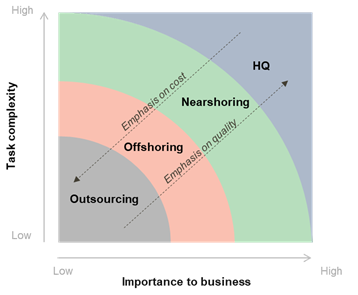Rightshoring – why you need it and how it should be approached
Businesses are realizing that the right placement of people and processes is a strategic differentiator. Applying a balanced mix of outsourced, offshored, and nearshored business functions can yield significant advantages to a company, both in terms of quality and cost. Indeed, Knowit is currently supporting a large Norwegian enterprise in their location- and shoring decision with focus on achieving a much more vigorous operating model while at the same time realizing significant cost-out effects.
In this article we guide you through the fundamentals of rightshoring and present a helpful tool that can be used for identifying the right location mix for your business functions.

We start by defining the terms associated with the rightshoring alternatives at hand.
- Headquarter
Locating the task within the corporate headquarter - Nearshoring
Locating a business function in close geographical and cultural proximity to HQ - Offshoring
Relocating a business function to a distant location: another region or continent - Outsourcing
Trusting a business function or a given task to a third-party unit, independent of location - Reshoring
Re-evaluating a shoring decision and moving one or more business functions
Traditionally, organizations have cut cost by offshoring certain tasks and processes to countries characterized by less stringent regulations and low wages. However, changing market dynamics has led several organizations down an alternative path. Increasing wages in developing countries, unexpected risks and unsuccessful shoring outcomes have driven global organizations to re- or nearshore business functions.
Simultaneously, digital technologies are generating new conditions and opportunities. Information technologies are creating new communication processes, RPA can handle large amounts of repetitive tasks and 3D printers are reshaping the manufacturing landscape.
Rightshoring is a means to achieve a great fit between business function and localized labor pool to achieve operational excellence in a digital world. To shore right, organizations must analyze the complexity involved in a set of tasks or processes, as well as how much control that is desired for that specific function.

Assess functions by complexity and importance
The Knowit Rightshoring Tool is a decision-making instrument for managing complexity across the operating model and cope with shifting market conditions. It evaluates the two primary characteristics of a business function: task complexity and business importance. Task complexity interprets the complexity of day-to-day operations of a given task, while importance to business is the level of control needed to operate the function according to organizational requirements.
Task complexity
Task complexity can be understood as the level of dependence to other business functions combined with the level of expertise needed to perform the task.
Complexity increases if the business function is closely linked to other functions. It can be dependent on outcome from or collaboration with one or more business functions to operate. This commonly requires it to be in timely, cultural and geographical proximity. Task complexity is lower if the business function performs well without considerable interaction with other functions.
Task complexity is high if the daily operations require specialized knowledge. On the other hand, business functions that require little expertise knowledge will have more emphasis on cost and less dependence on location. Routine tasks are typical low on complexity, while tasks that require frequent problem solving and decision making are higher.
When analyzing function specific task complexity, it is valuable to look for standardization potential. Standardization of work processes lowers complexity and increases efficiency. Moreover, standardization enables a business function to look for automation potential, which implies that employees can spend less time on performing routine tasks.
Key considerations for analyzing task complexity
- Are the daily tasks dependent on one or more other functions?
- Do the daily tasks require a high level of knowledge?
Importance to business
Level of business importance is decided based on the need for risk management and the business function’s strategic priority.
Business function that require a high level of risk management are typically those that are exposed to cyber risks, confidentiality concerns or privacy policies. Similarly, protection of intellectual property is becoming increasingly important and require a high level of risk management. Business functions that are not prone to risk require less frequent control and overview.
Strategic priority is to what degree the function is regarded as a part of the core business. A function has high strategic priority if it serves as a differentiator; thus, it is a prioritized function for competitiveness. It is valuable to have such functions close to the headquarter to ensure the required overview of the performance.
Key considerations for analyzing business importance
- Does the business unit serve as a strategic differentiator?
- What level of risk management does the function require?
The analysis of task complexity and business importance gives direction to what rightshoring alternative should be applied. From merely outsourcing a task to having a function co-located with corporate headquarters. High task complexity and importance to business for a given function implies it is important to have it very well governed. If the function is less important to business and the tasks are easy to perform, it is natural to outsource it to external parties. Customer service is an example of a function that is suitable for nearshoring. It is important to business, is dependent on other functions and should be performed by own personnel in close cultural and geographical proximity to home markets. Accounts payable/receivable tasks within Finance, is an example of a function that is suitable for offshoring. Less important to core business, however an important prerequisite for daily operations implying that control is needed, but geographic proximity is less important.

The Knowit Rightshoring tool provides important guidance to rightshoring decisions
Applying the right mix of the rightshoring alternatives gives the optimal trade-off between quality and cost for business functions in large enterprises. A prerequisite for success is segmenting your tasks, understanding interdependencies, and getting an overview of standardization potential prior to making any structural decisions.
We at Knowit have several years of experience with advising and supporting organizations in achieving their optimal fit for locations and functions.
Interested in your rightshoring opportunities or simply want to know more?
Contact Kristian Kjernsmo, Head of Next Generation Operating Model at Knowit Insight.
kristian.kjernsmo@knowit.no


